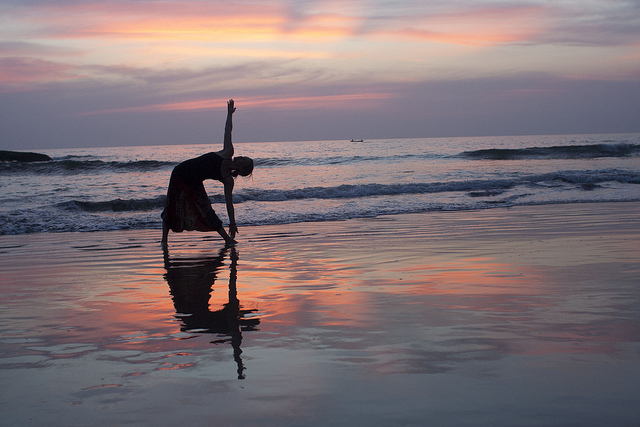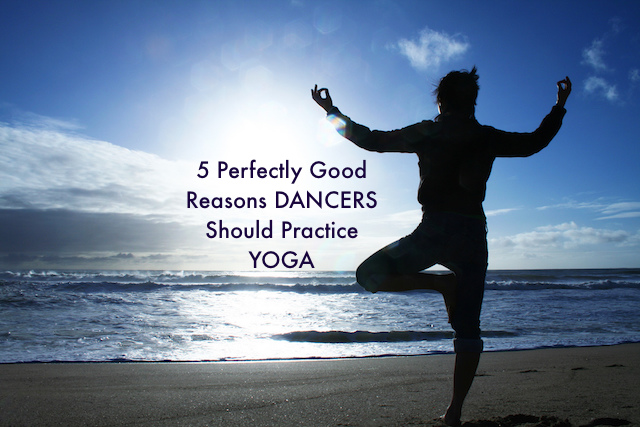
All dancers are ultimately on the same quest: to become better, stronger dancers. But in order to reach beyond their limits, many dancers find they need additional training methods besides dance, and yoga is a popular choice.
But why?
Why is yoga one tool no dancer’s survival kit should be without?
Increased body awareness
While all dance classes focus on position and alignment, yoga classes take this one step further. The slower pace of a yoga class naturally allows for greater precision. For example, instead of just putting your feet into a parallel position, you have time to check that the outside edges of your feet line up the with the outside edges of your mat, your weight is equally distributed to all four corners of your feet, your toes are spread wide and your pinky toes are anchored firmly into the floor.
By taking the time to fine tune the details of proper alignment (including your pinky toes) you learn to build each pose from the ground up to create a strong foundation, and to stack the joints for greater stability and power. In this way, every movement is conscious and deliberate, a moving meditation. Moving slowly and deliberately allows more opportunity to notice and correct habits that might create issues over time, such as rolling in or out on your ankles as you balance.
Increased strength and flexibility
Many of the standing poses in yoga develop the same muscles that are used for developpés, battements, and jumps, while other poses build strength in areas that are often overlooked. The upper body strength developed from downward dog and handstands is useful during promenades and lifts with a partner. Balancing poses have direct application in center floor (particularly during adagio) and backbends and back strengthening poses such as the locust pose help develop a killer arabesque.
Even though dancers are flexible, most of us have certain tight areas. Poses that focus on these areas will help you unlock greater range of movement and since yoga stretches are generally held for longer periods, you get greater results and make the body less prone to injury.
Linking breath to movement
One of the most valuable tools you will learn in yoga is breath control. Many dancers haven’t been taught to use the breath to help power certain actions. Even worse, we sometimes forget to breathe at all. Most yoga classes begin with tuning into the breath, focusing on lengthening the inhale and exhale, and working from there to maintain a slow, steady breath through the rest of class. Inhales are used for expanding movements, such as arching your back or lifting a leg, exhales are naturally suited for contracting actions such as stepping into a lunge or bending into a forward fold. Learning to link breath to movement helps you harness the energy of breath and use it to your advantage, which is especially helpful during challenging combinations like big jumps or long adagio sequences where you need extra power.
Focused breathing has a few other benefits: it helps to keep your mind from wandering, and serves as a way to measure when you have gone too far past your limits. If it’s too challenging to stay for at least three breaths in a pose then that’s a clear indication you are pushing too hard. Developing this awareness is a way to learn to tune into your body’s pain responses so you can avoid injuries.

Health benefits
Aside from the more obvious physical perks, yoga also works on a subtle level that isn’t immediately apparent. Spinal twists, for instance, not only keep the spine pliable, they also put gentle pressure on the internal organs, which has a detoxifying effect on the body. Inversions such as handstands and headstands reverse the blood flow, redistribute blood throughout the body, and improve circulation. This helps the mind feel clearer and calmer and may also ensure a healthier heart and lungs. Studies have found that regular yoga practice improves coordination, reaction time, memory, and even IQ scores.
Peace of mind
An important component of yoga is taking a break from the chaotic pace of today’s busy world through focusing on the present. Yoga encourages you to relax, slow your breath, and focus on the here and now; this breath, this pose, this moment. This shifts the balance from your sympathetic nervous system (the fight-or-flight part of the brain) to the parasympathetic nervous system (the calming and restorative part of the brain). It also lowers the heart rate and decreases blood pressure.
Yoga practice has also been shown to improve depression and increase serotonin levels. Yoga and meditation build awareness, and the more aware you are, the easier it is to break free of destructive emotions like anger and stress and add a little more calm wisdom to your thinking. Yoga poses were originally designed to prepare the body to be able to sit in meditation and many people who practice yoga find they carry the meditative quality of yoga with them throughout the rest of their activities. Some decide to add regular meditation to maintain and grow these peaceful feelings.
Become your best self
Clearly, the benefits of yoga go beyond the physical; yoga is also a way to soothe the spirit and find peace of mind.
Whether you are looking to build strength, improve flexibility and balance, or just recalibrate your brainwaves to a more relaxed state, yoga has a lot to offer dancers. By learning to align your body, mind and spirit on the mat you will bring your best self to your dance.
How does yoga help YOU?

Grier Cooper has performed on three out of seven continents with companies such as San Francisco Ballet, Miami City Ballet, and Pacific Northwest Ballet, totaling more than thirty years of experience as a dancer, teacher and performer.
She blogs about dance in the San Francisco Bay Area and has interviewed and photographed a diverse collection dancers and performers including Clive Owen, Nicole Kidman, Glen Allen Sims and Jessica Sutta. She is the author of Build a Ballerina Body and the new ballet-based young adult novel, WISH. Grier can be reached through her website at http://www.griercooper.com

Dance Advantage welcomes guest posts from other dance teachers, students, parents, professionals, or those knowledgeable in related fields. If you are interested in having your article published at Dance Advantage, please see the following info on submitting a guest post. Read posts from guest contributors.

